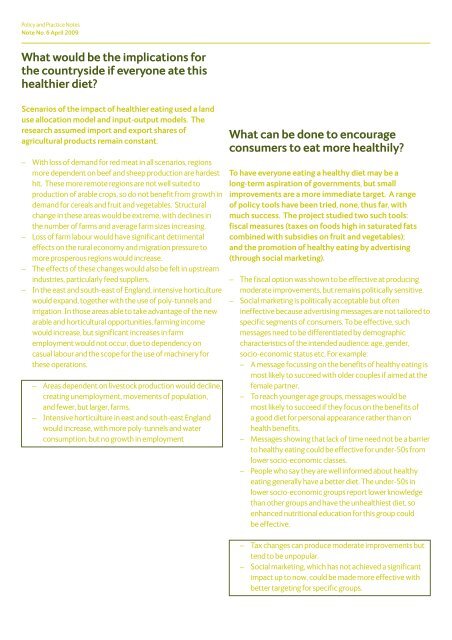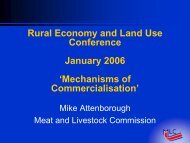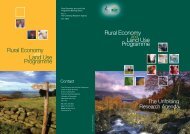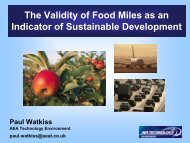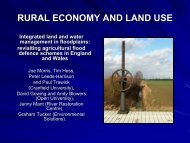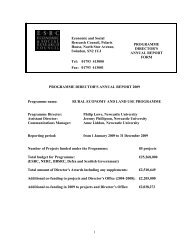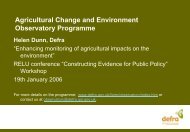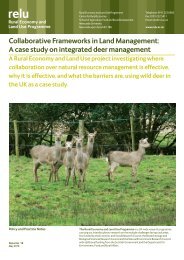11291 RELU PP6:PROOF - Rural Economy and Land Use Programme
11291 RELU PP6:PROOF - Rural Economy and Land Use Programme
11291 RELU PP6:PROOF - Rural Economy and Land Use Programme
Create successful ePaper yourself
Turn your PDF publications into a flip-book with our unique Google optimized e-Paper software.
Policy <strong>and</strong> Practice Notes<br />
Note No. 6 April 2009<br />
What would be the implications for<br />
the countryside if everyone ate this<br />
healthier diet?<br />
Scenarios of the impact of healthier eating used a l<strong>and</strong><br />
use allocation model <strong>and</strong> input-output models. The<br />
research assumed import <strong>and</strong> export shares of<br />
agricultural products remain constant.<br />
– With loss of dem<strong>and</strong> for red meat in all scenarios, regions<br />
more dependent on beef <strong>and</strong> sheep production are hardest<br />
hit. These more remote regions are not well suited to<br />
production of arable crops, so do not benefit from growth in<br />
dem<strong>and</strong> for cereals <strong>and</strong> fruit <strong>and</strong> vegetables. Structural<br />
change in these areas would be extreme, with declines in<br />
the number of farms <strong>and</strong> average farm sizes increasing.<br />
– Loss of farm labour would have significant detrimental<br />
effects on the rural economy <strong>and</strong> migration pressure to<br />
more prosperous regions would increase.<br />
– The effects of these changes would also be felt in upstream<br />
industries, particularly feed suppliers.<br />
– In the east <strong>and</strong> south-east of Engl<strong>and</strong>, intensive horticulture<br />
would exp<strong>and</strong>, together with the use of poly-tunnels <strong>and</strong><br />
irrigation. In those areas able to take advantage of the new<br />
arable <strong>and</strong> horticultural opportunities, farming income<br />
would increase, but significant increases in farm<br />
employment would not occur, due to dependency on<br />
casual labour <strong>and</strong> the scope for the use of machinery for<br />
these operations.<br />
– Areas dependent on livestock production would decline,<br />
creating unemployment, movements of population,<br />
<strong>and</strong> fewer, but larger, farms.<br />
– Intensive horticulture in east <strong>and</strong> south-east Engl<strong>and</strong><br />
would increase, with more poly-tunnels <strong>and</strong> water<br />
consumption, but no growth in employment<br />
What can be done to encourage<br />
consumers to eat more healthily?<br />
To have everyone eating a healthy diet may be a<br />
long-term aspiration of governments, but small<br />
improvements are a more immediate target. A range<br />
of policy tools have been tried, none, thus far, with<br />
much success. The project studied two such tools:<br />
fiscal measures (taxes on foods high in saturated fats<br />
combined with subsidies on fruit <strong>and</strong> vegetables);<br />
<strong>and</strong> the promotion of healthy eating by advertising<br />
(through social marketing).<br />
– The fiscal option was shown to be effective at producing<br />
moderate improvements, but remains politically sensitive.<br />
– Social marketing is politically acceptable but often<br />
ineffective because advertising messages are not tailored to<br />
specific segments of consumers. To be effective, such<br />
messages need to be differentiated by demographic<br />
characteristics of the intended audience: age, gender,<br />
socio-economic status etc. For example:<br />
– A message focussing on the benefits of healthy eating is<br />
most likely to succeed with older couples if aimed at the<br />
female partner.<br />
– To reach younger age groups, messages would be<br />
most likely to succeed if they focus on the benefits of<br />
a good diet for personal appearance rather than on<br />
health benefits.<br />
– Messages showing that lack of time need not be a barrier<br />
to healthy eating could be effective for under-50s from<br />
lower socio-economic classes.<br />
– People who say they are well informed about healthy<br />
eating generally have a better diet. The under-50s in<br />
lower socio-economic groups report lower knowledge<br />
than other groups <strong>and</strong> have the unhealthiest diet, so<br />
enhanced nutritional education for this group could<br />
be effective.<br />
– Tax changes can produce moderate improvements but<br />
tend to be unpopular.<br />
– Social marketing, which has not achieved a significant<br />
impact up to now, could be made more effective with<br />
better targeting for specific groups.


